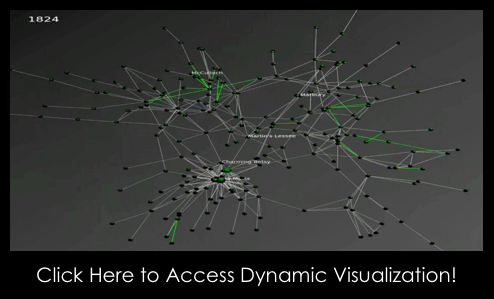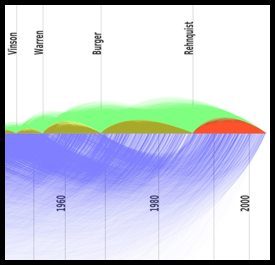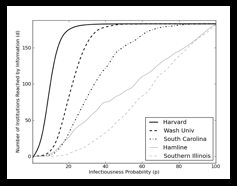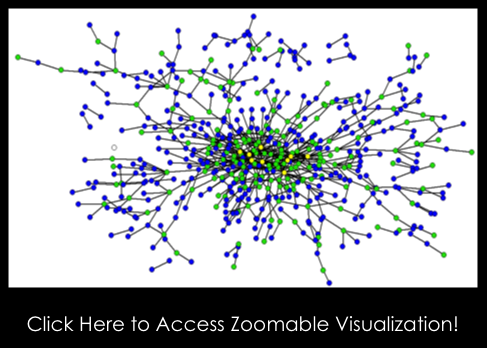0. Final Version of Slides from the Network Analysis and Law Tutorial @ Jurix 2011 –
1. Brief Description of the Tutorial –
 Prior to the 2011 Jurix Conference on Legal Knowledge and Information Systems, Professor Daniel Martin Katz (Michigan State University, College of Law) and Michael Bommarito (University of Michigan – Center for the Study of Complex Systems) will present a tutorial on Network Analysis and Law.
Prior to the 2011 Jurix Conference on Legal Knowledge and Information Systems, Professor Daniel Martin Katz (Michigan State University, College of Law) and Michael Bommarito (University of Michigan – Center for the Study of Complex Systems) will present a tutorial on Network Analysis and Law.
While historically allied with mathematical sociology , developments in network science have been generated by a wide range of disciplines, with major recent contributions offered by fields such as applied mathematics and statistical physics. Applied graph theorists often refer to networks as dependency graphs because they formalize the underlying linkages between objects. Whether the objects in question are webpages on the internet, individuals in a social network such as Facebook or software dependencies in computer programming, the study of networks is the ‘science of our times.’
Building upon the developments in this interdisciplinary field, legal scholars and social scientists recently have begun to apply the tools of network science to bring new insight to a variety of long standing questions. This tutorial is designed to introduce this emerging field to intellectually curious scholars.
2. Goals for the Session
- To introduce a variety of concepts from complex systems and network science
- To outline potential applications of network science in legal studies and positive legal theory
- To highlight possible uses of network metadata to enrich legal informatics sub-fields such as information retrieval
- To examine the application of various network based epidemiological / diffusion models
- To introduce participants to various theoretical and empirical network science software platforms
3. Examples of Network Analysis and Law
(a) Judicial Citation Networks
 One very fruitful application for the tools of network science is to study the ‘evolution’ of the common law through the prism of judicial citations. Indeed, a distinguishing feature of a common law system is the precedential weight that judicial actors attach to prior decisions. Judges presented with questions in a given case consider how to apply doctrines from prior cases. Taken in the aggregate, common law systems produce vast amounts of citation data and although there is a rich literature studying these citations, relatively little scholarship has applied the tools of network science. As applied to legal citations, each reference between the various cases in the network is represented by a directed edge (arc) and each case is represented by a node. Citation networks are a special class of network called a dynamic directed acyclic graph (D-DAG). (See dynamic visualization above).
One very fruitful application for the tools of network science is to study the ‘evolution’ of the common law through the prism of judicial citations. Indeed, a distinguishing feature of a common law system is the precedential weight that judicial actors attach to prior decisions. Judges presented with questions in a given case consider how to apply doctrines from prior cases. Taken in the aggregate, common law systems produce vast amounts of citation data and although there is a rich literature studying these citations, relatively little scholarship has applied the tools of network science. As applied to legal citations, each reference between the various cases in the network is represented by a directed edge (arc) and each case is represented by a node. Citation networks are a special class of network called a dynamic directed acyclic graph (D-DAG). (See dynamic visualization above).
The properties of such graphs are a matter of active study in the physical science community. As we describe in Bommarito, Katz & Zelner (2009) “Citation networks are inherently directed graphs. The citing node asserts that a relationship exists with the cited node, never vice versa. Citation networks are the result of a generative process with identifiable constraints: arcs are only created when the tail node of the arc is created, and the head nodes must exist prior to the tail node.” Many traditional graph methods rely upon closed triangles or cycles. The strict head and tail ordering of a legal citation network yields a graph without cycle (i.e. an acyclic graph) as documents written at a given time cannot cite documents written in the future. Finally, citation networks are dynamic as the relative relationships between objects are updated as each additional document (and its citations) are added to the existing graph.
(b) Networks of Legal Elites
The American Federal Judiciary
The American Law Professoriate
4. About the Instructors
 Professor Daniel Martin Katz is an Assistant Professor of Law at Michigan State University. He has previously taught quantitative methods (including network science) in a variety of venues including most recently at the prestigious University of Michigan – ICPSR Summer Program. http://computationallegalstudies.com/icpsr-class/
Professor Daniel Martin Katz is an Assistant Professor of Law at Michigan State University. He has previously taught quantitative methods (including network science) in a variety of venues including most recently at the prestigious University of Michigan – ICPSR Summer Program. http://computationallegalstudies.com/icpsr-class/
Professor Katz has published articles in scholarly journals such as Physica A, Proceedings of the International Conference on Artificial Intelligence and Law, Cornell Journal of Law and Public Policy, Virginia Tax Review, Ohio State Law Journal, Journal of Legal Education, and the Journal of Law and Politics. His work also has been featured in print and online outlets including the New York Times, The Globe and Mail, Slate, Wired Magazine Blog, U.S. News & World Report Blog, Financial Times Blog, Huffington Post, National Law Journal, and Marginal Revolution. Professor Katz is also an avid blogger; his posts can be found at http://computationallegalstudies.com/
Professor Katz received his Ph.D. in Political Science and Public Policy from the University of Michigan. Prior to coming to Michigan State, he was a fellow in Empirical Legal Studies at the University of Michigan Law School and an NSF-IGERT Fellow at the University of Michigan Center for the Study of Complex Systems. He graduated cum laude from the University of Michigan Law School where he received his J.D. in 2005.
 Michael J. Bommarito II is PhD Pre-Candidate, University of Michigan, Department of Political Science. Michael is also an affiliate at the University of Michigan, Center for the Study of Complex Systems. He has previously taught quantitative methods (including network science) in a variety of venues including most recently at the prestigious University of Michigan – ICPSR Summer Program. http://computationallegalstudies.com/icpsr-class/
Michael J. Bommarito II is PhD Pre-Candidate, University of Michigan, Department of Political Science. Michael is also an affiliate at the University of Michigan, Center for the Study of Complex Systems. He has previously taught quantitative methods (including network science) in a variety of venues including most recently at the prestigious University of Michigan – ICPSR Summer Program. http://computationallegalstudies.com/icpsr-class/
Michael has presented mathematical, financial, political, and legal research to over 20 different groups around the world, including students, academic institutions, government agencies, and industry members. His research and publications have been featured in the New York Times, U.S. Senate, Seeking Alpha, Financial Times, Zero Hedge, Huffington Post, Abnormal Returns, Marginal Revolution, and Wired Magazine. His work has been published in Quantitative Finance, Physica A, Journal of Legal Education, Proceedings of the International Conference on Artificial Intelligence and Law and Virginia Tax Review.
5. Some FAQ’s
 When / Where? How much does it cost? How advanced is the material?
When / Where? How much does it cost? How advanced is the material?
Jurix 2011 Tutorial @ Universität Wien (December 13, 2011). Tutorial is Free and will be held in conjunction with the Jurix 2011 (Vienna, Austria) pre-conference Tutorials. This willl be an introductory tutorial in Network Analysis and the Law. Thus, it does not assume any prior knowledge on the part of the attendee.
6. Some Background Articles – Applied Network Analysis and Law
 Daniel Martin Katz, Joshua Gubler, Jon Zelner, Michael Bommarito, Eric Provins & Eitan Ingall, Reproduction of Hierarchy? A Social Network Analysis of the American Law Professoriate, 61 Journal of Legal Education 76 (2011).
Daniel Martin Katz, Joshua Gubler, Jon Zelner, Michael Bommarito, Eric Provins & Eitan Ingall, Reproduction of Hierarchy? A Social Network Analysis of the American Law Professoriate, 61 Journal of Legal Education 76 (2011).
Michael Bommarito, Daniel Martin Katz, Jonathan Zelner & James Fowler, Distance Measures for Dynamic Citation Networks, 389 Physica A (2010).
Daniel Katz & Derek Stafford, Hustle and Flow: A Social Network Analysis of the American Federal Judiciary, 71 Ohio State Law Journal 457 (2010).
Yonatan Lupu & James Fowler, The Strategic Content Model of Supreme Court Opinion Writing, APSA – Toronto Meeting Paper (2009).
Michael Bommarito, Daniel Martin Katz & Jonathan Zelner, Law as a Seamless Web? Comparison of Various Network Representations of the United States Supreme Court Corpus (1791-2005) in Proceedings of the 12th Intl. Conference on Artificial Intelligence and Law (2009).
Michael Bommarito, Daniel Martin Katz, Jonathan Zelner, On the Stability of Community Detection Algorithms for Longitudinal Citation Data in Proceedings of the 6th Conference on Applications of Social Network Analysis (ASNA 2009 – ETH Zurich)
Frank Cross, Thomas Smith & Antonio Tomarchio, The Reagan Revolution in the Network of Law, 57 Emory L. J. 1227 (2008).
James Fowler & Sangick Jeon, The Authority of Supreme Court Precedent, 30 Soc. Networks 16 (2008).
Daniel Katz, Derek Stafford & Eric Provins, Social Architecture, Judicial Peer Effects and the Evolution of the Law: Toward a Positive Theory of Judicial Social Structure, 23 Georgia State Law Review 975 (2008) [Symposium: Dynamical Jurisprudence – Law as a Complex System]
Elizabeth Leicht, Gavin Clarkson, Kerby Shedden & Mark Newman, Large-Scale Structure of Time Evolving Citation Networks, 59 European Physics Journal B 75 (2007).
Thomas Smith, The Web of the Law, 44 San Diego L.R. 309 (2007).
James Fowler, Timothy R. Johnson, James F. Spriggs II, Sangick Jeon & Paul J. Wahlbeck, Network Analysis and the Law: Measuring the Legal Importance of Precedents at the U.S. Supreme Court, 15 Political Analysis, 324 (2007).


